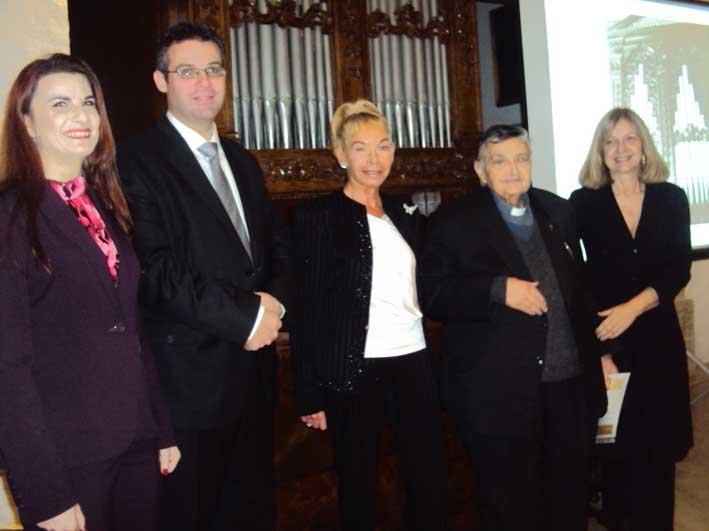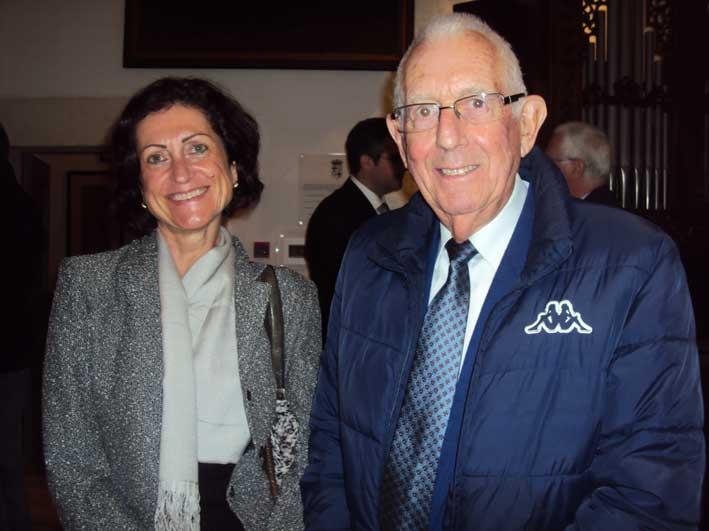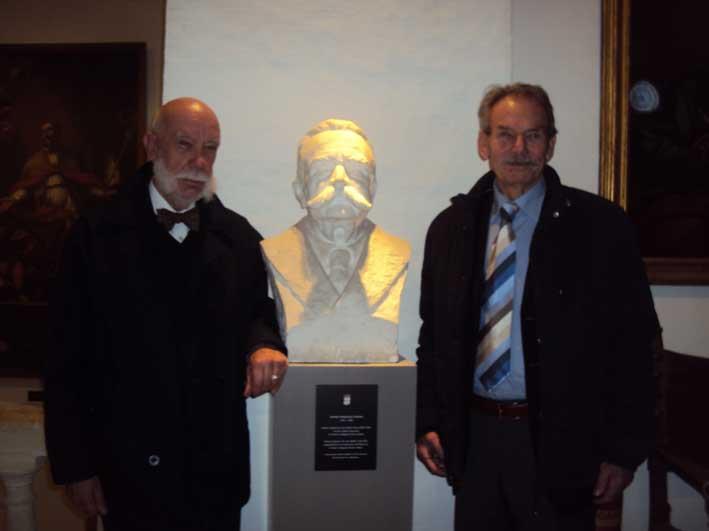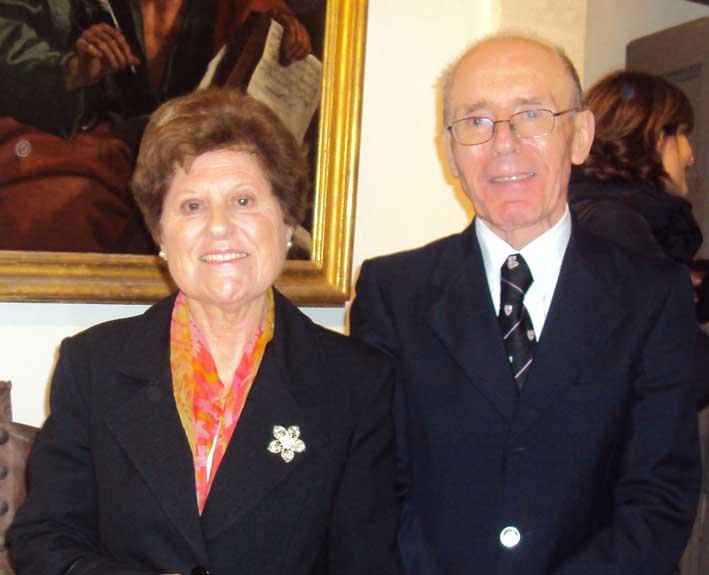Marie Amélie Dewavrin is almost a household name in Malta. She is President of the Institute of Maltese Culture, founded in 1998, lives in Malta for many months of the year and has helped so many in various ways because of her generosity. She has concluded such a significant number of projects that it is not possible to record them here. All this is a result of her coming to Malta for a short visit and falling in love with the place. She was particularly impressed with the history and large number of historic buildings to be found on such a small island and with the long association Malta has had with France. We tend to forget that more than half the Knights of Malta were French; three of the seven existing Langues were French and almost half of the 28 Grand Masters ruling in Malta were French with our capital Valletta having been built by one of them.

Ing. Buhagiar & his wife Audrey; Mme Dewavrain, Mgr Azzopardi and H.E.
The IMC has organized concerts and exhibitions in France promoting Maltese artists and musicians - pianist Stefan Cassar and Carmine Lauri immediately come to mind. Among the books published by IMC is Guide de Malte and more recently a book on the trade of Maltese oranges between Malta and France in the 18th century written by Prof. Alain Blondy and based on documents in the archives of the Wignacourt Museum in Rabat. There is both a French and an English version of this book. Madame Dewavrain has also sponsored scientific research by French and Maltese scientists.
The Wignacourt Museum is once more in the limelight and a recipient of her generosity. Mme Dewavrin had already sponsored other restorations in Rabat so, over the years, has become a friend of Mgr John Azzopardi who had been trying to get sponsorship for the restoration of a positivo organ (positive meaning that it is portable) built in 1754 by a famous Sicilian organbuilder, Annibale Lo Bianco of Galati Mamertino, Messina, for Mgr Azzopardi is well aware of its importance and fine qualities. Ing. Robert Buhagiar, who restored this organ, mentioned to me that a couple of years ago a group of Sicilian scholars came to Malta specifically to visit the two Lo Bianco organs 'such is the fame of Lo Bianco!' Unfortunately they could not visit the Wignacourt Lo Bianco as it was dismantled while under restoration, but Ing.Buhagiar took them to Tarxien 'and they were so excited to see the other Lo Bianco organ in that church.'

Mme Laurence Laude (French embassy) and her father
When Mgr Azzopardi approached Mme Dewavrin about the organ at the Wignacourt Museum she agreed to pay for its restoration over a period of three years. Robert Buhagiar who is not only an electrical engineer but also a pipe organ builder and restorer took it under his wing and the result is little short of magnificent.
* * *
On the evening of the inaugural concert on the restored Lo Bianco organ Ing. Buhagiar gave us an excellent power point presentation and also a concert, for he is an accomplished organist, too. The audience enjoyed several short pieces of music among them those composed by Francesco Azopardi (1748-1809), Baldassere Galuppi (1706-1785), Louis C. D'Aquin (1694-1772), Emanuele Galea (1790-1850), Louis Nicholas Clerambault (1676-1749) and J.S. Bach (1685-1750).

Prof. Blondy & Sig. Mauro Tomaselli
Ing. Buhagiar told me that he has been playing the piano since the age of five and at thirteen, started playing the pipe organ at his parish church in Zabbar. He found an excellent teacher when he was 20: Mro Albert Borg, O.S.A., 'better known as Patri Bert. He was maestro di capella at Mdina Cathedral and St John's Co-Cathedral for about 50 years. It was he who introduced me to Mascioni, an Italian firm founded in 1829 which is possibly the oldest and one of the most prestigious organbuilding firms in Europe, where I eventually trained in organ building,' Ing. Buhagiar explained. In 1999 he set up a pipe-organ restoration workshop in Zabbar. He started with the restoration of the 1922 pneumatic organ at Siggiewi Parish Church which was a big success recognized by both local and foreign organists. He keeps constantly in touch with foreign organbuilders, organists and musicologists for advice and the sharing of knowledge. In 2003 he became the first, and only, Maltese member of the International Society of Organbuilders. He is very much committed to protecting and enhancing the organbuilding heritage of the Maltese Islands.
* * *

Mr & Mrs Frans Ciappara
It is obvious to those of us who listen to organ music regularly that organs too, have their own personality. Is this Lo Bianco organ in any way special I asked him? 'Each organ is a unique creation. Some feature more refined craftsmanship and artistic characteristics than others. The feature which is most immediately evident in this organ is its case, certainly the most beautiful intricately carved organ case of all the 'positivo' organs in Malta. Indeed it is truly a work of art, expertly restored by wood-restorer James Saliba' is his reply. Ing. Buhagiar tells me that it was built by a famous Sicilian organbuilder of whom we only have one other organ in Malta - the that at Tarxien Parish Church. 'The craftsmanship employed in the construction of the organ apparatus and pipework is very high indeed and this translated into the organ being a fine musical instrument both technically (in the way it responds to the organist's touch) and tonally. Following its restoration it has been visited and played by professional musicians like Diego Cannizzaro, Gianluca Libertucci and Mahan Esfahani who all agree that we are so lucky to have this particularly precious jewel in the Maltese Islands' organ heritage.' And also so very lucky to have philanthropists like Madame Dewavrin who is ready to financially support such worthy causes which continue to enrich our heritage and culture. Few organs such as this exist around the world. Most of them must be rotting quietly in their gallaries waiting to be resurrected like this beautiful organ.
* * *
Madame Dewavrain's short speech was typical of her. She keeps a low profile and simply dispenses goodness whenever she can. In a different way it is the same with Mgr Azzopardi. He wears his learning lightly but is totally dedicated to the work at hand.
What a pleasure to be among such people who are so selfless in whatever they are doing. They are life enhancers. We need more of them to balance out those who aren't.
[email protected]